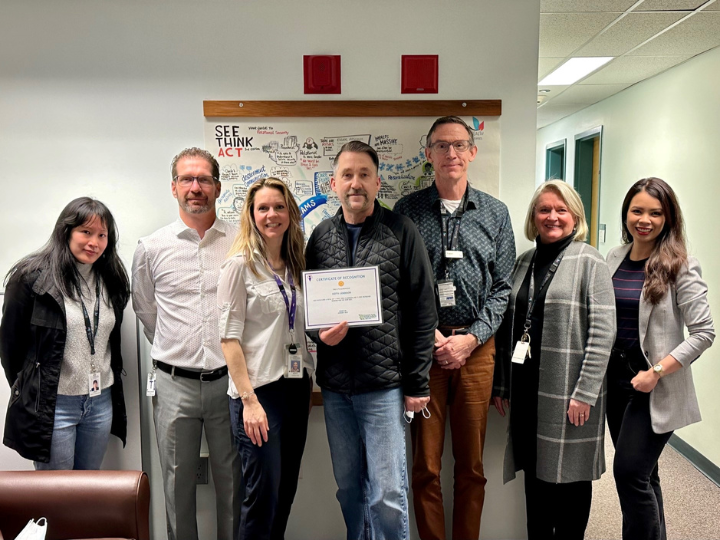Use this image as both the current Page Image and for News listings
Working in a high-risk environment in health care is not easy. Code whites, or incidents where staff witness violent or aggressive behaviour, require staff to be prepared and confident in their violence prevention knowledge when these situations occur.
At PHSA, violence prevention training has been highly successful, due in part to the work of peer facilitators like Alex Velasco and Keith Johnson, who guide their colleagues in training.
Alex Velasco has been a Provincial Violence Prevention Curriculum (PVPC) peer facilitator for over five years. In this role, he leads his peers in training and is able to build on his passion for teaching and connecting with new staff.
“Being able to pass on my knowledge and real life experiences to my peers and give them the confidence to operate on the floor safely has been rewarding.” – Alex Velasco
 Team members at Red Fish Healing Centre for Mental Health and Addiction receive facilitator recognition awards for their efforts as PVPC peer facilitators.
Team members at Red Fish Healing Centre for Mental Health and Addiction receive facilitator recognition awards for their efforts as PVPC peer facilitators.
For Gurjeevan Dhami, a nurse at Red Fish Healing Centre, participating in violence prevention training means she can go to work alongside her peers feeling safe. Throughout her training experience, learning directly from peer facilitators helped her gain unique knowledge that was specific to the patients and environment at Red Fish.
“I felt that peer facilitators could provide a better clinical picture because of their direct experience. I learned a lot about de-escalation, how to approach different situations and I felt confident relying on them in code white scenarios,” says Gurjeevan.
Having a peer facilitator on a team can help maintain a safe environment for everyone in a hospital. Patients often experience better outcomes when staff learn how to de-escalate tricky situations confidently. “By verbally de-escalating, we can use hands-on intervention as a last resort so the patient feels safe and supported,” says Trevor Aarbo, senior director, Patient Care Services at the Forensic Psychiatric Hospital.
 Linda Lam, Brendan McLellan, Maria Dadiotis, Keith Johnson, Trevor Aarbo, Claire O’Quinn and Tiffany Ladines pose as Keith receives a facilitator recognition award.
Linda Lam, Brendan McLellan, Maria Dadiotis, Keith Johnson, Trevor Aarbo, Claire O’Quinn and Tiffany Ladines pose as Keith receives a facilitator recognition award.
Trevor works with Keith Johnson, instructor and health care worker, who has been a peer facilitator for years. Because of his experience, Keith is able to provide new team members with hospital-specific information when going through the Provincial Violence Prevention Curriculum, giving them added confidence in stressful situations.
“It’s very reassuring to me to know that we have a skilled facilitator and instructor like Keith, delivering the curriculum to new people that haven’t worked in a forensic hospital before,” says Trevor.
Thank you to peer facilitators like Keith and Alex, as well as all clinical educators, coordinators and facilitators for their work to guide teams in this important training!

